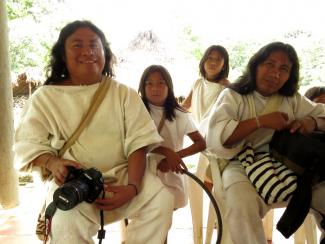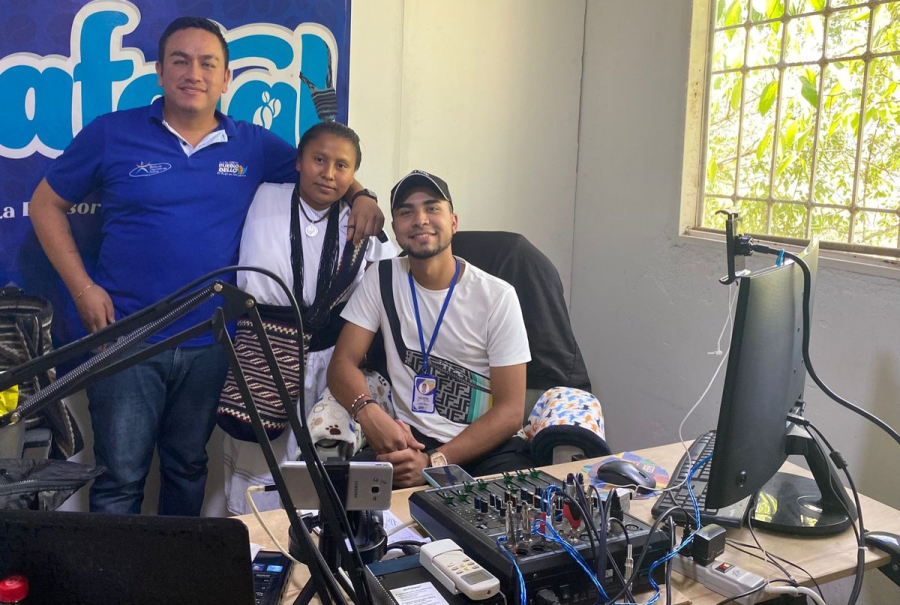
Read the expanded article here.
The breathtaking mountains of the Sierra Nevada de Santa Marta on the Caribbean coast of Colombia are the sacred ancestral lands of four Indigenous Peoples: the Kogi, Arhuaco, Wiwa, and Kankuamo. It is the world’s tallest coastal mountain range, containing nearly every ecosystem on the planet: glaciers, tundra, alpine lakes, deserts, rainforests, wetlands, and coral reefs.
The inhabitants, direct descendants of an ancient civilization known as the Tayrona, speak distinct languages but share the belief that they are the guardians of the heart of the world. At the core of their spirituality and cosmology is the belief that the mountain range is a living entity, whom, before being created by the great creator Sezhankwa, existed in the spiritual universe. The great creator then birthed the people of the Sierra Nevada and gave the mandate to uphold her Original Law: that all creation must be protected and nurtured.
Through deep meditation, ritual offerings, songs, and prayers carried out along a network of interconnected sacred sites, the Mamos (Kogi priests) follow the law of caring for the Sierra Nevada—thus maintaining the equilibrium of life for their sacred mountains, and the entire world. The Kogi are concerned that non-Indigenous people, the “younger brothers,” are plundering and dismembering the Earth. They see this evidenced in the prolonged droughts and disappearing glaciers in their own mountains. Jose de Los Santos Sauna, Kogi Cabildo governor, cautions, “If the sacred sites in the heart of the world are not protected...calamity will befall the entire world. The younger brother is not heeding our warnings.”
The Kogi were one of only a handful of tribes in Colombia that defied the Spanish conquistadores by moving high up into the mountains to their traditional spiritual centers, where they continued to live for centuries in relative isolation. Over the 500 years since colonization, however, the Kogi and other peoples of Sierra Nevada have lost most of the mid-to-lower elevation reaches of their ancestral lands.
Recuperating Ancestral Territory
The village of Dumingueka is located in the lower foothills of the Sierra Nevada in the Santa Clara River Basin. Five years ago the Kogi reoccupied this valley, establishing a new community and building their first intercultural school for Kogi youth. Since the 1970s, the Kogi, Arhuaco, Wiwa, and Kankuamo have struggled to secure legal recognition to some 6,500 square kilometers of their ancestral territories in three resguardos (Indigenous reserves), collectively inhabited by about 90,000 people.
Named after the tallest and most sacred peak of the range, the Gonawindua Tayrona Organization (OGT) was established in 1987 to defend the traditions and cultures of the peoples of the Sierra Nevada. Today the OGT is mostly focused on the direction, organization, administration, and management of the Kogi reserve, while the other three tribes have established similar organizations. In 1999, the four tribes formed the Territorial Council of Cabildos (CTC) to speak in one voice to better govern their ancestral territory and maintain autonomy. The CTC addresses the protection of sacred sites, the unification of their ancestral territories, and threats from mining, dams, and other mega projects. According to Santos, the top priority is the recuperation of an additional 3,500 square kilometers of ancestral territories, including areas that are legally Indigenous lands but still owned and occupied by farmers, ranchers, and developers.
Another concern is the defense and recuperation of their sacred sites; in particular 54 important sites that form an invisible “black line” encircling the base of the mountain massif. “Our sacred sites along the black line refer to the invisible line separating the land and the sea,” Santos says. “We are eager to protect our sacred sites because [they] are like the eyes, ears, lungs, arms of nature. Each site is a Being, a mother or father spirit who is alive and has a spirit. If these things are destroyed, it will bring an end to our Indigenous culture; it will destroy us as a people.”
The Desecration of Jukulwa
One of the most important sacred sites on the black line is Jukulwa. Located on the Caribbean coast, it is a place of significance for holding ceremonies to defend against the spread of diseases among humans and animals. A consortium of Colombian and Brazilian businessmen and politicians are currently building a multipurpose seaport there called Puerto Brisa, which includes roads and a railroad to connect with the proposed San Juan del Cesar coal mine.
In 2007, the tribes filed an injunction in Constitutional Court; in 2008, the consortium began dynamiting the site illegally. The Court ruled in 2010 that the port was illegal and construction had to stop pending prior informed consultation and agreement with the affected Indigenous people. In 2011, the Kogi participated in another consultation process and voiced their opposition, demanding that the site be protected. However, the consultation process failed to produce a resolution, and the case was left to the Court. In the meantime, the Colombian Ministry of Environment issued an environmental license for the port, allowing the construction—and devastation—to continue.
The consultation initially held in 2007 did not meet the necessary requirements; there was no preparation of an associated environmental impact study in which the Mamos could participate. During the consultation, the Mamos of all four tribes visited more than 20 sacred sites within the boundaries of the Puerto Brisa project, explaining the function and purpose of each site. The tribes’ representatives and allied organizations submitted this information in volumes of writings, graphics, and tables. However, the information was not widely disseminated in the media, nor was it included in the Court’s official records. The Kogi refused to settle for compensation, which would compromise their Indigenous law of origin. The Court still has not issued its final verdict on the injunction and the Puerto Brisa continues, and each day the Mamos watch in horror as their spiritual mothers and fathers are destroyed.
Sovereignty and Economic Empowerment
While the fate of Jukulwa hangs in limbo, the Kogi are working toward autonomous economic empowerment by developing a small-scale, spiritually cultivated coffee enterprise. Coffee is an important source of income for food and clothing, and it has been grown and traded by Kogi for decades. Without a community cooperative or association, though, growers have been vulnerable to middlemen—until now. Five hundred families are participating in a program established by the OGT that offers technical assistance with processing, marketing, and quality control. The OGT plans to use income from coffee production to purchase sacred sites, strengthen cultural practices, and provide funding for autonomous governance, including their ongoing community assemblies.
The Kogi, Wiwa, Arhuaco, and Kankuamo of the Sierra Nevada are working in both the physical and spiritual realms to protect and defend the sacred heart of the world. They are nurturing the life force of nature, which in turn keeps the world alive in a continuous cycle of reciprocity.
—Atossa Soltani is the founder and executive director of Amazon Watch. Evelyn Arce (Chibcha) is executive director of International Funders for Indigenous Peoples.
To learn more about the Kogi, visit their website: gonawindua.com, or
email jose_ sauna@hotmail.com.



